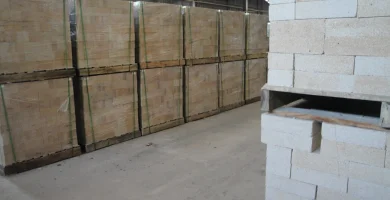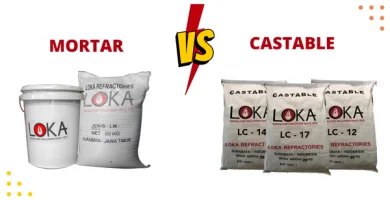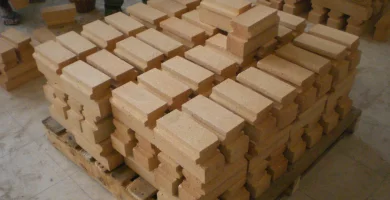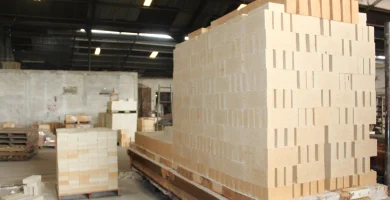 Need Fire Clay Brick and High Alumina Brick Refractories? Here's Some Info For You!
Need Fire Clay Brick and High Alumina Brick Refractories? Here's Some Info For You!Loka Refractories - Brick is a refractory material that is very commonly found and used.
Based on its shape, Brick refractory is classified into shaped refractory, because it is through a molding process using a press machine so that it has a definite shape.
Like refractory materials in general, brick refractories are also classified into several types, you know!
One of the most commonly used types of refractory bricks is alumina silicate brick (fire clay brick) and high alumina bricks.
Fire clay brick and high alumina brick? What kind of refractory is that?
Fire clay bricks and high alumina bricks have various combinations of alumina and silica content. They range from almost 100% alumina with a little silica, to almost 100% silica with a little alumina.
In addition, the material also has several features including:
-High resistance to thermal shock, abrasion and chemical;
-Easy and wide application;
-Low cost;
-etc.
Refractory stone is commonly used in lining furnaces, kilns, incinerators, and the like. Each stone is glued together using a refractory cement mortar with similar specifications.
Classification of fire clay brick and high alumina brick
Eits, not quite up there! Fire clay bricks are also classified based on physical properties including: Super-duty, High-duty, Semi-silica, Medium-duty, and Low-duty.
Meanwhile, high alumina bricks are classified based on their alumina content, from 50% to 99%.
Does Loka Refractories produce fire clay bricks and high alumina bricks?
Of course! we produce fire clay bricks (SK-32, SK-34, SK-36) and high alumina bricks (SK-38) with a standard size of 230x114x65 mm.
We also provide arch, wedge, and key types. You can also order according to your needs!
Just send the drawings/specifications needed to:
E-mail : info@lokarefractories.com
Phone : 031-7663307
Whatsapp : 0821-4280-8500
Learn MoreBased on its shape, Brick refractory is classified into shaped refractory, because it is through a molding process using a press machine so that it has a definite shape.
Like refractory materials in general, brick refractories are also classified into several types, you know!
One of the most commonly used types of refractory bricks is alumina silicate brick (fire clay brick) and high alumina bricks.
Fire clay brick and high alumina brick? What kind of refractory is that?
Fire clay bricks and high alumina bricks have various combinations of alumina and silica content. They range from almost 100% alumina with a little silica, to almost 100% silica with a little alumina.
In addition, the material also has several features including:
-High resistance to thermal shock, abrasion and chemical;
-Easy and wide application;
-Low cost;
-etc.
Refractory stone is commonly used in lining furnaces, kilns, incinerators, and the like. Each stone is glued together using a refractory cement mortar with similar specifications.
Classification of fire clay brick and high alumina brick
Eits, not quite up there! Fire clay bricks are also classified based on physical properties including: Super-duty, High-duty, Semi-silica, Medium-duty, and Low-duty.
Meanwhile, high alumina bricks are classified based on their alumina content, from 50% to 99%.
Does Loka Refractories produce fire clay bricks and high alumina bricks?
Of course! we produce fire clay bricks (SK-32, SK-34, SK-36) and high alumina bricks (SK-38) with a standard size of 230x114x65 mm.
We also provide arch, wedge, and key types. You can also order according to your needs!
Just send the drawings/specifications needed to:
E-mail : info@lokarefractories.com
Phone : 031-7663307
Whatsapp : 0821-4280-8500
 Mortar Vs Castable Refractories, What's The Difference?
Mortar Vs Castable Refractories, What's The Difference?Loka Refractories - In this article, we will discuss the differences between mortar and castable, two types of monolithic refractories.
Some people may be confused by the difference between mortar and castable, because in terms of shape the two materials are quite familiar. Both are monolithic refractories in the form of dry grains.
In fact, the two materials are practically similar but not the same. Want to know the difference? Check out the info in this article!
Mortars
Mortar is a refractory cement that functions as a refractory brick adhesive. Therefore, the type of mortar must be in accordance with the type of brick applied.
Before use, it is necessary to add water or other additives to the fire mortar.
There are two types of mortar, namely heat setting and air setting. Heat setting mortar is in the form of dry granules and will only harden after being heated causing sintering.
While air setting is in the form of a paste and can harden immediately after contact with air.
Castable
Castable or refractory cast is a monolithic refractory material that can be applied on floors and walls of boilers, furnsces, kilns, or shaped as needed. Castable also can be shaped as needed so that it can be installed in parts where it is not possible to install refractory stones.
Before application, castable must be mixed with clean water. As with heat setting mortar, castable is in the form of dry granules.
Castable is classified into several types based on its CaO content, namely Regular castable, Low Cement Castable, and Ultra Low Cement Castable.
Differences of Mortars and Castables
Based on the explanation above, it can be concluded that the differences between mortar and castable are:
Mortar serves as an adhesive for refractory bricks, while castable could be served as a substitute for refractory bricks.
Mortars and castables can be applied to lining furnaces, boilers, kilns, similar instruments which experience direct contact with heat and flames.
Need Mortar and Castable Refractory Cement?
Loka Refractories produces mortar and castable refractory materials with specifications according to your needs. Contact us at:
E-mail : info@lokarefractories.com
Phone : 031-7663307
Whatsapp : 0821-4280-8500
Learn MoreSome people may be confused by the difference between mortar and castable, because in terms of shape the two materials are quite familiar. Both are monolithic refractories in the form of dry grains.
In fact, the two materials are practically similar but not the same. Want to know the difference? Check out the info in this article!
Mortars
Mortar is a refractory cement that functions as a refractory brick adhesive. Therefore, the type of mortar must be in accordance with the type of brick applied.
Before use, it is necessary to add water or other additives to the fire mortar.
There are two types of mortar, namely heat setting and air setting. Heat setting mortar is in the form of dry granules and will only harden after being heated causing sintering.
While air setting is in the form of a paste and can harden immediately after contact with air.
Castable
Castable or refractory cast is a monolithic refractory material that can be applied on floors and walls of boilers, furnsces, kilns, or shaped as needed. Castable also can be shaped as needed so that it can be installed in parts where it is not possible to install refractory stones.
Before application, castable must be mixed with clean water. As with heat setting mortar, castable is in the form of dry granules.
Castable is classified into several types based on its CaO content, namely Regular castable, Low Cement Castable, and Ultra Low Cement Castable.
Differences of Mortars and Castables
Based on the explanation above, it can be concluded that the differences between mortar and castable are:
Mortar serves as an adhesive for refractory bricks, while castable could be served as a substitute for refractory bricks.
Mortars and castables can be applied to lining furnaces, boilers, kilns, similar instruments which experience direct contact with heat and flames.
Need Mortar and Castable Refractory Cement?
Loka Refractories produces mortar and castable refractory materials with specifications according to your needs. Contact us at:
E-mail : info@lokarefractories.com
Phone : 031-7663307
Whatsapp : 0821-4280-8500
 Not Only Heat Resistant, These Are Refractory Properties
Not Only Heat Resistant, These Are Refractory PropertiesLoka Refractories - Umumnya, material refractory diketahui masyarakat sebagai material tahan panas atau tahan api.
Namun, pada kenyataannya refractory tidak sebatas itu saja. Material refractory memiliki sifat-sifat khusus yang membedakannya dengan material batu bata dan semen lainnya.
Apa saja sifat-sifat refractory? Mari kita simak penjelasan di bawah.
Sifat-Sifat Refractory Secara Umum
Untuk diklasifikasikan sebagai refractory, material tersebut harus memiliki sifat-sifat berikut diantaranya:
1. Kemampuan menahan suhu tinggi.
2. Kemampuan menahan kejut suhu.
3. Kemampuan menahan kerja leburan logam, gas panas dan erosi terak, dll.
4. Kemampuan menahan beban pada kondisi pemakaian.
5. Kemampuan menahan beban dan gaya abrasif.
6. Kemampuan menyimpan panas.
7. Kemampuan tidak mengkontaminasi bahan yang berkontak.
8. Kemampuan menjaga kestabilan dimensi yang cukup pada suhu tinggi dan setelah/selama siklus panas berulang (koefisien muai panas rendah).
Selain secara umum, refractory juga memiliki sifat-sifat thermal, mekanis, dan fisik. Beberapa sifat tersebut diantaranya:
Sifat Thermal, Mekanis, dan Fisik Refractory
1. Refractoriness
Refractoriness yaitu ketahanan material refractory pada suhu tinggi. Sifat ini juga disebut sebagai PCE atau Pyrometric Cone Equivalence.
Pengujiannya dilakukan dengan menggunakan alat berupa tabel pancang/Pyrometric Cone dengan membandingkan test cone dan standard cone pada temperatur tertentu.
Nilai PCE penting untuk menentukan klasifikasi refractory, maximum service temperatur, identifikasi bahan baku, dan sebagai salah satu parameter kontrol dalam penambangan mineral.
2. Refractoriness Under Load (RUL)
Seperti refractoriness, RUL diperlukan untuk menentukan maximum temperature, namun dalam kondisi beban tekan. RUL penting untuk mengetahu kodisi tekanan tinggi.
3. Permanent Linear Change (PLC)
PLC yaitu perubahan refractory setelah dibakar pada atmosfer, waktu, dan temperatur tertentu tanpa tekanan eksternal. PLC dinyatakan dalam satuan persen (%).
4. Thermal Conductivity
Thermal conductivity yaitu kuantitas panas yang akan mengalir melalui suatu satuan luas dalam arah normal terhadap luas permukaan dalam waktu tertentu.
Menetapkan thermal conductivity diperlukan karena setiap komposisi memiliki sifat transmisi yang berbeda.
5. Thermal Shock
Thermal shock yaitu kemampuan refractory untuk bertahan teradap perubahan temperatur seara mendadak.
6. Cold Crushing Strength
Cold crushing strength atau kuat tekan yaitu kemampuan refractory brick atau bata tahan api untuk bertahan terhadap beban kompresi pada suhu kamar.
7. Porositas
Porositas yaitu volume pori-pori yang terbuka pada produk refractory sebagai presentase volume total, dimana cairan dapat menembus.
Semakin rendah porositas maka semakin baik karena membuat refractory memiliki high strength, high abberation resistance, dan low srinkage.
8. Bulk Density
Bulk density yaitu jumlah bahan refractory dalam suatu volume. Semakin meningkat bukl density maka semakin meningkat stabilitas volume, kapasitas panas, dan ketahanan terhadap penetrasi terak.
9. Slag Resistance
Slag resistance atau ketahanan terhadap slag ditentukan dengan menguji pengaruh jumlah dan komposisi slag pada temperatur tertentu terhadap refractory.
Refractory Berkualitas dari Loka Refractories
Demikian sifat-sifat refractory secara umum juga. Sifat-sifat tersebut penting dimiliki mengingat material refractory tidak hanya mengalami kontak dengan suhu tinggi, mereka juga akan mengalami kontak dengan zat kimia lainnya yang dapat memiliki sifat korosif.
Dapatkan material refractory yang teruji kualitasnya dengan menghubungi:
PT. Loka Refractories Wira Jatim
E-mail : info@lokarefractories.com
Phone : 031-7663307
Whatsapp : 0821-4280-8500
Learn MoreNamun, pada kenyataannya refractory tidak sebatas itu saja. Material refractory memiliki sifat-sifat khusus yang membedakannya dengan material batu bata dan semen lainnya.
Apa saja sifat-sifat refractory? Mari kita simak penjelasan di bawah.
Sifat-Sifat Refractory Secara Umum
Untuk diklasifikasikan sebagai refractory, material tersebut harus memiliki sifat-sifat berikut diantaranya:
1. Kemampuan menahan suhu tinggi.
2. Kemampuan menahan kejut suhu.
3. Kemampuan menahan kerja leburan logam, gas panas dan erosi terak, dll.
4. Kemampuan menahan beban pada kondisi pemakaian.
5. Kemampuan menahan beban dan gaya abrasif.
6. Kemampuan menyimpan panas.
7. Kemampuan tidak mengkontaminasi bahan yang berkontak.
8. Kemampuan menjaga kestabilan dimensi yang cukup pada suhu tinggi dan setelah/selama siklus panas berulang (koefisien muai panas rendah).
Selain secara umum, refractory juga memiliki sifat-sifat thermal, mekanis, dan fisik. Beberapa sifat tersebut diantaranya:
Sifat Thermal, Mekanis, dan Fisik Refractory
1. Refractoriness
Refractoriness yaitu ketahanan material refractory pada suhu tinggi. Sifat ini juga disebut sebagai PCE atau Pyrometric Cone Equivalence.
Pengujiannya dilakukan dengan menggunakan alat berupa tabel pancang/Pyrometric Cone dengan membandingkan test cone dan standard cone pada temperatur tertentu.
Nilai PCE penting untuk menentukan klasifikasi refractory, maximum service temperatur, identifikasi bahan baku, dan sebagai salah satu parameter kontrol dalam penambangan mineral.
2. Refractoriness Under Load (RUL)
Seperti refractoriness, RUL diperlukan untuk menentukan maximum temperature, namun dalam kondisi beban tekan. RUL penting untuk mengetahu kodisi tekanan tinggi.
3. Permanent Linear Change (PLC)
PLC yaitu perubahan refractory setelah dibakar pada atmosfer, waktu, dan temperatur tertentu tanpa tekanan eksternal. PLC dinyatakan dalam satuan persen (%).
4. Thermal Conductivity
Thermal conductivity yaitu kuantitas panas yang akan mengalir melalui suatu satuan luas dalam arah normal terhadap luas permukaan dalam waktu tertentu.
Menetapkan thermal conductivity diperlukan karena setiap komposisi memiliki sifat transmisi yang berbeda.
5. Thermal Shock
Thermal shock yaitu kemampuan refractory untuk bertahan teradap perubahan temperatur seara mendadak.
6. Cold Crushing Strength
Cold crushing strength atau kuat tekan yaitu kemampuan refractory brick atau bata tahan api untuk bertahan terhadap beban kompresi pada suhu kamar.
7. Porositas
Porositas yaitu volume pori-pori yang terbuka pada produk refractory sebagai presentase volume total, dimana cairan dapat menembus.
Semakin rendah porositas maka semakin baik karena membuat refractory memiliki high strength, high abberation resistance, dan low srinkage.
8. Bulk Density
Bulk density yaitu jumlah bahan refractory dalam suatu volume. Semakin meningkat bukl density maka semakin meningkat stabilitas volume, kapasitas panas, dan ketahanan terhadap penetrasi terak.
9. Slag Resistance
Slag resistance atau ketahanan terhadap slag ditentukan dengan menguji pengaruh jumlah dan komposisi slag pada temperatur tertentu terhadap refractory.
Refractory Berkualitas dari Loka Refractories
Demikian sifat-sifat refractory secara umum juga. Sifat-sifat tersebut penting dimiliki mengingat material refractory tidak hanya mengalami kontak dengan suhu tinggi, mereka juga akan mengalami kontak dengan zat kimia lainnya yang dapat memiliki sifat korosif.
Dapatkan material refractory yang teruji kualitasnya dengan menghubungi:
PT. Loka Refractories Wira Jatim
E-mail : info@lokarefractories.com
Phone : 031-7663307
Whatsapp : 0821-4280-8500
 Refractory Materials: Definition, Use, and Application
Refractory Materials: Definition, Use, and ApplicationLoka Refractories - Refractory materials can be said to be the breath of industries that use heat energy directly or indirectly.
So, what is refractory and what are their use and applications? Read the article below!
What is refractory material?
Refractory is a material that can maintain its physical form and chemical content after being exposed to high heat for a relatively long time. If translated literally, refractory means something that is stubborn.
Not only in language, there are several definitions of refractory including:
1. According to ASTM 71, a refractory is defined as a non-metallic material which has the chemical and physical properties that can be used for structure or as a component of a system, which is in an environmental temperature above 1000 °F (811 °K; 538 °C) .
2. According to JIS R 2001-1985, refractory is a material with a fixed shape that is durable at high temperatures (> 1500 °C) and shapeless materials (mortar, castable, plastic, etc.) and refractory bricks with a usage temperature of > 800 ° C.
Why are refractory materials needed?
The function of the refractory is not limited to holding high temperatures, including:
1. Protects the walls of the reactor/furnace against high temperatures, hot gases, catalysts, melts and solvents. So that the lifetime becomes longer;
2. Reducing heat loss or heat coming out of the furnace, boilers, and kilns;
3. Maintaining the stability of the operating temperature in the equipment;
4. Protect workers from the threat of high heat.
After knowing about the refractory function, you must be curious about its application, right?
No need to worry! Just scroll down a little bit and you will know how refractory materials are used.
The Application of Refractory Materials
Refractory can be applied to linings in thermal processes (melting, firing, heat-treatment furnaces) for the metal and non-metal industries.
In the metallurgical industry, a refractory material is applied to the inner lining of the tool to contain and convey metal and slag.
Whereas in the non-metal industry, refractory is applied to fired heaters, hydrogen reformers, catalytic cracking units, coke calciners, sulfur furnaces, air heaters, ducting, chimneys, and the like.
In addition to the explanation above, refractory is also used as heat insulation, or as a heat sink so it doesn't come out of the tool.
Refractory materials consist of various kinds according to the needs of the application.
How could we find refractory materials?
Indonesia has a lot of refractory material manufacturers. But how could we find the best refractory materials that required for our industry?
If that’s what you’re looking for, just call Loka Refractories! We will supply best quality materials that can be customized as per your requirements to keep your business going.
You can submit your inquiry to:
Loka Refractories
E-mail : info@lokarefractories.com
Phone : 031-7663307
Whatsapp : 0821-4280-8500
Learn MoreSo, what is refractory and what are their use and applications? Read the article below!
What is refractory material?
Refractory is a material that can maintain its physical form and chemical content after being exposed to high heat for a relatively long time. If translated literally, refractory means something that is stubborn.
Not only in language, there are several definitions of refractory including:
1. According to ASTM 71, a refractory is defined as a non-metallic material which has the chemical and physical properties that can be used for structure or as a component of a system, which is in an environmental temperature above 1000 °F (811 °K; 538 °C) .
2. According to JIS R 2001-1985, refractory is a material with a fixed shape that is durable at high temperatures (> 1500 °C) and shapeless materials (mortar, castable, plastic, etc.) and refractory bricks with a usage temperature of > 800 ° C.
Why are refractory materials needed?
The function of the refractory is not limited to holding high temperatures, including:
1. Protects the walls of the reactor/furnace against high temperatures, hot gases, catalysts, melts and solvents. So that the lifetime becomes longer;
2. Reducing heat loss or heat coming out of the furnace, boilers, and kilns;
3. Maintaining the stability of the operating temperature in the equipment;
4. Protect workers from the threat of high heat.
After knowing about the refractory function, you must be curious about its application, right?
No need to worry! Just scroll down a little bit and you will know how refractory materials are used.
The Application of Refractory Materials
Refractory can be applied to linings in thermal processes (melting, firing, heat-treatment furnaces) for the metal and non-metal industries.
In the metallurgical industry, a refractory material is applied to the inner lining of the tool to contain and convey metal and slag.
Whereas in the non-metal industry, refractory is applied to fired heaters, hydrogen reformers, catalytic cracking units, coke calciners, sulfur furnaces, air heaters, ducting, chimneys, and the like.
In addition to the explanation above, refractory is also used as heat insulation, or as a heat sink so it doesn't come out of the tool.
Refractory materials consist of various kinds according to the needs of the application.
How could we find refractory materials?
Indonesia has a lot of refractory material manufacturers. But how could we find the best refractory materials that required for our industry?
If that’s what you’re looking for, just call Loka Refractories! We will supply best quality materials that can be customized as per your requirements to keep your business going.
You can submit your inquiry to:
Loka Refractories
E-mail : info@lokarefractories.com
Phone : 031-7663307
Whatsapp : 0821-4280-8500
 Expanding the Refractory Market in Southeast Sulawesi, Loka Refractories signed a Cooperation Agreement with Perumda of Kendari City
Expanding the Refractory Market in Southeast Sulawesi, Loka Refractories signed a Cooperation Agreement with Perumda of Kendari CityLoka Refractories - PT. Loka Refractories Wira Jatim collaborated with a regional public company in Kendari, South Sulawesi, namely Perumda Kota Kendari in expanding the market for refractory materials in the Southeast Sulawesi region.
This collaboration was finalized by signing a cooperation agreement on Perumda Kota Kendari's work visit agenda in Surabaya last Tuesday, October 4th, 2022.
Previously, the two companies had signed an MoU at the East Java Province Trade and Investment Mission held in Kendari last July.
As a follow up, cooperation agreements were signed by each of the main directors, namely Aria Soebagio (PT. Loka Refractories) and Munir Madjid (Perumda Kendari).
Representative from Loka Refractories' holding, PT. Panca Wira Usaha Jawa Timur (PT. PWU Jatim), Rivo Hernardus was also present to witness the signing of the agreement.
The agenda was followed by a visit to PT. Loka Refractories' factory guided by Production Manager.
The factory visit was carried out in order to add insight to the Perumda Kota Kendari as a distributor in the process of producing refractory materials.
Perumda Kota Kendari's visit at PT. Loka Refractories Wira Jatim ended with a presentation of product knowledge as a provision for Perumda Kota Kendari in marketing refractory products in the Southeast Sulawesi region.
Learn MoreThis collaboration was finalized by signing a cooperation agreement on Perumda Kota Kendari's work visit agenda in Surabaya last Tuesday, October 4th, 2022.
Previously, the two companies had signed an MoU at the East Java Province Trade and Investment Mission held in Kendari last July.
As a follow up, cooperation agreements were signed by each of the main directors, namely Aria Soebagio (PT. Loka Refractories) and Munir Madjid (Perumda Kendari).
Representative from Loka Refractories' holding, PT. Panca Wira Usaha Jawa Timur (PT. PWU Jatim), Rivo Hernardus was also present to witness the signing of the agreement.
The agenda was followed by a visit to PT. Loka Refractories' factory guided by Production Manager.
The factory visit was carried out in order to add insight to the Perumda Kota Kendari as a distributor in the process of producing refractory materials.
Perumda Kota Kendari's visit at PT. Loka Refractories Wira Jatim ended with a presentation of product knowledge as a provision for Perumda Kota Kendari in marketing refractory products in the Southeast Sulawesi region.
 Loka Refractories Signed an MoU with KAD Jatim, Preventing Acts of Corruption in the Company's Internal Environment
Loka Refractories Signed an MoU with KAD Jatim, Preventing Acts of Corruption in the Company's Internal EnvironmentLoka Refractories - As a commitment by Loka Refractories in implementing corporate governance that is clean from acts of corruption, a Memorandum of Understanding (MoU) was signed by the Director of Loka Refractories, Aria Soebagio and Chairman of the East Java Anti-Corruption Advocacy Committee (KAD), Dr. Reswanda SPI, MM.
The signing of the MoU was also witnessed by the Main Commissioner of PT. Loka Refractories, Lutfil Hakim.
The event which took place on Wednesday, September 7th 2022 was followed by a Panel Discussion with the theme of "Creating Individuals with Integrity as the Foundation for Creating a Corruption-Free Work Environment at PT. Loka Refractories Wira Jatim" with Dr. Reswanda SPI, MM. and Dr. Ronny Mustamu as the speaker.
The panel was also attended by the Managers, Supervisors and Foremen of PT. Refractories Workshop.
Learn MoreThe signing of the MoU was also witnessed by the Main Commissioner of PT. Loka Refractories, Lutfil Hakim.
The event which took place on Wednesday, September 7th 2022 was followed by a Panel Discussion with the theme of "Creating Individuals with Integrity as the Foundation for Creating a Corruption-Free Work Environment at PT. Loka Refractories Wira Jatim" with Dr. Reswanda SPI, MM. and Dr. Ronny Mustamu as the speaker.
The panel was also attended by the Managers, Supervisors and Foremen of PT. Refractories Workshop.


